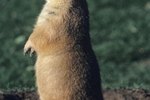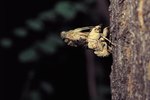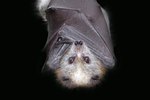How to Identify Woodchuck Burrows. A hole in the ground can be ominous since you just never know what is sleeping inside. Luckily, woodchuck burrows have some distinctive characteristics that will allow you to identify them.
Measure the hole. Woodchuck burrows will have a large opening about 10 to 12 inches across, with a raised mound of dirt just outside. This mound is one of the most obvious signs of a woodchuck burrow. Often there will be one to three additional escape openings without the mounds, which are usually camouflaged.
Note the location of the hole and its surroundings. Woodchucks choose to live near food sources, so their burrows will be in grassy areas. If the grass is high, such as in the spring, woodchucks will tramp down trails, which will radiate from the burrow.
Note whether there are droppings located outside the burrow. Woodchucks are highly organized and clean animals, so their burrows actually have a separate room called an excrement chamber. If there are abundant droppings outside the burrow, then it probably doesn't belong to a woodchuck.
Observe the design. Woodchuck burrows have steep entrances that drop down about 5 feet, and then level out to extend around 30 feet. The burrow will have two chambers: the sleeping chamber where the animal will sleep and raise its young, and an excrement chamber.
Determine whether the animal should be hibernating. Woodchucks actually have two separate burrows, one for winter and one for summer. Winter burrows will display the same characteristics as summer burrows, except they may be in a more sheltered area, and the entrances will be closed with dirt.
Note whether the burrow appears to be occupied by more than one animal. Only during mating will two adult woodchucks share a den.
Tips
Don't destroy woodchuck burrows. Though some people consider them a nuisance, woodchucks are beneficial for the environment. Their excrement fertilizes the earth and their burrowing turns over and aerates the soil. In New York State alone, woodchucks turn over 1.6 million tons of soil a year.
Warnings
Never approach a burrow unless you are positive whose home it is. Rabbits, opposum, raccoons, foxes and even skunks will renovate and occupy vacated woodchuck burrows. Watch for burrows as you trek through any grassy area within a woodchuck's natural range. Woodchuck burrows are large enough for a human, horse or herd animal to step in, which could result in serious injury. Woodchucks generally only wander about 50 to 150 feet away from their homes, so be mindful that the animal is likely to be nearby if you identify a burrow.
Writer Bio
This article was written by the CareerTrend team, copy edited and fact checked through a multi-point auditing system, in efforts to ensure our readers only receive the best information. To submit your questions or ideas, or to simply learn more about CareerTrend, contact us [here](http://careertrend.com/about-us).





